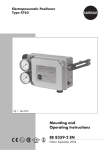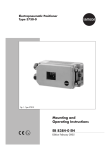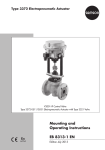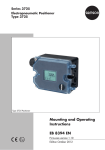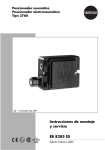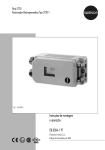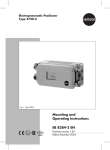Download Mounting and Operating Instructions EB 8359-2
Transcript
Type 4763 Electropneumatic Positioner Type 4763 Electropneumatic Positioner Mounting and Operating Instructions EB 8359-2 EN Edition April 2014 Definition of signal words DANGER! Hazardous situations which, if not avoided, will result in death or serious injury WARNING! Hazardous situations which, if not avoided, could result in death or serious injury 2 NOTICE Property damage message or malfunction Note: Additional information Tip: Recommended action EB 8359-2 EN Contents 1 General safety instructions..............................................................................4 2 Article code....................................................................................................5 3 Technical data................................................................................................6 4 Design and principle of operation...................................................................8 5 Attachment..................................................................................................10 5.1 Attachment to valve with cast yoke.................................................................10 5.2 Attachment to valve with rod-type yoke...........................................................10 5.3 Housing cover..............................................................................................10 6 Connections.................................................................................................12 6.1 Electrical connections....................................................................................12 6.2 Pneumatic connections..................................................................................13 6.3 Pressure gauge.............................................................................................13 6.4 Supply pressure............................................................................................14 7 Operation....................................................................................................15 7.1 7.1.1 Assignment of the positioner and the actuator.................................................15 Determining and changing the operating direction..........................................16 7.2 Starting point and reference variable..............................................................18 7.3 7.3.1 7.3.2 7.3.3 Adjustment after mounting the positioner on the valve......................................18 Setting the air delivery (volume restriction Q) and proportional band Xp...........18 Setting for actuator with fail-safe action “stem extends”....................................20 Setting for actuator with fail-safe action “stem retracts”....................................20 7.4 Exchanging the range spring.........................................................................21 8 Converting the electropneumatic into a pneumatic positioner.........................22 9 Servicing explosion-protected devices...........................................................24 10 Maintenance, calibration and work on equipment.........................................25 11 Accessories and mounting parts....................................................................26 12 Dimensions in mm........................................................................................27 Test certificates.............................................................................................28 EB 8359-2 EN 3 General safety instructions 1 General safety instructions For your own safety, follow these instructions concerning the mounting, start up and operation of the positioner: −− The positioner is to be mounted, started up or operated only by trained and experienced personnel familiar with the product. According to these mounting and operating instructions, trained personnel is referred to as individuals who are able to judge the work they are assigned to and recognize possible dangers due to their specialized training, their knowledge and experience as well as their knowledge of the applicable standards. −− Explosion-protected versions of this positioner are to be operated only by personnel who has undergone special training or instructions or who is authorized to work on explosion-protected devices in hazardous areas. −− Any hazards that could be caused in the valve by the process medium, the signal pressure or by moving parts are to be prevented by taking appropriate precautions. −− If inadmissible motions or forces are produced in the pneumatic actuator as a result of the supply pressure level, it must be restricted using a suitable supply pressure reducing station. −− Proper shipping and storage are assumed. 4 Note: Devices with a CE marking fulfill the requirements of the Directives 94/9/EC and 2004/108/EC. The Declaration of Conformity is available on request. EB 8359-2 EN Article code 2 Article code Electropneumatic positioners Type 4763- x 1 x 0 0 x x x x 0 x 0 x x 0 Explosion protection Without 0 Ex II 2 G Ex ia IIC T6 Gb according to ATEX 1 CSA/FM intrinsically safe/non incendive 3 2/7 Ex II 3 G Ex nA II T6 Gc/Ex ic IIC T6 Gc for Zone 2 acc. to ATEX 8 2/7 Spring Spring 1, travel = 15 mm 1 Spring 2, travel = 30 mm, split range 15 mm 2 Spring 3, travel = 60 mm, split range 30 mm 3 Pneumatic connections ISO 228/1 G ¼ 1 ¼-18 NPT 3 Electrical connection (cable gland) M20 x 1.5 blue (plastic) 1 M20 x 1.5 black (plastic) 2 M20 x 1.5 (nickel-plated brass) 7 2 i/p converters Type 6109 1 Type 6112 2 Reference variable 4 to 20 mA 0 0 to 20 mA 2 2 1 to 5 mA 2 3 Temperature range Standard 0 Low temperature down to –45 °C 2 2 Special version Without For oxygen 1) 0 0 0 0/1 Ex II 3D IP 54 T 80 °C (with manufacturer's declaration) 8 GOST certificate 8 1) 0 1 6 2/7 0 1 8 2 0 1 0 Special version suitable for oxygen up to maximum +60 °C (according to AIR LIQUIDE test report no. 2014/R 171a1) EB 8359-2 EN 5 Technical data 3 Technical data Controlled variable (travel range) 7.5 to 60 mm, with lever extension: 7.5 to 90 mm Reference variable Split-range 0 to 50 % or 50 to 100 % reference variable span (up to 50 mm travel) 4 to 20 mA (Ex), 4 to 20 mA (without explosion protection), 0 to 20 mA, 1 to 5 mA, Range spring See Table 1 on page 19 Supply air 1.4 to 6 bar (20 to 90 psi) Air quality acc. to ISO 8573-1: Max. particle size and density: Class 4 Oil content: Class 3 · Pressure dew point: Class 3 Signal pressure pst (output) Max. 0 to 6.0 bar (0 to 90 psi) Characteristic Linear characteristic Deviation from terminal-based conformity ≤ 1.5 % Hysteresis < 0.5 % Sensitivity < 0.1 % Operating direction Reversible Proportional band Xp (at 1.4 bar supply air) 1 to 3.0 % with spring 1 1 to 2.0 % with spring 2 1 to 1.5 % with spring 3 Air consumption in steady state (Xp = 1 %) With 1.4 bar supply air: 0.19 mn³/h With 6 bar supply air: 0.5 mn³/h Air output At Δp 1.4 bar: 3.0 mn³/h At Δp 6 bar: 8.5 mn³/h Transit time with Type 3271 Actuator, “stem extends” 240 cm² ≤ 1.8 s 350 cm² ≤ 2.5 s 700 cm² ≤ 10.0 s Perm. ambient temperature 3), 4) With Type 6109 i/p Converter: –20 to +70 °C –35 to +70 °C (metal cable gland) 1) Ri = 250 Ω 2) Ri = 200 Ω 2) Ri = 200 Ω 2) Ri = 880 Ω 2) With Type 6112 i/p Converter: –20 to +80 °C –40 to +80 °C (metal cable gland) –45 to +80 °C (special version) 6 EB 8359-2 EN Technical data Influences Temperature: < 0.03 %/1 K Supply air: < 0.3 %/0.1 bar Vibrations: < 2 % between 10 up to 150 Hz and 4 g Variable position when turned by 180°: < 3.5 % Degree of protection IP 54 · Venting over check valve (1790-7408): IP 65 Electromagnetic compatibility Complying with EN 61000-6-2, EN 61000-6-3 and EN 61326-1 Weight Approx. 1.2 kg Materials Housing External parts 1) 2) 3) 4) Die-cast aluminum, chromated and plastic coated Stainless steel The data listed in the certificate of conformity applies to the version with type of protection Ex ia IIC. Ri = Coil resistance (at approx. 20 °C) ± 7 % tolerance Observe the limits in the certificate of conformity for explosion-protected versions. With special version suitable for oxygen up to maximum +60 °C EB 8359-2 EN 7 Design and principle of operation 4 Design and principle of operation The electropneumatic positioner is used to assign the valve position (controlled variable) to the input signal (reference variable). The positioner compares the control signal of a control system to the travel of the control valve and issues a signal pressure (output variable) for the pneumatic actuator. The positioner consists of an electropneumatic converter unit (21) and a pneumatic unit equipped with a lever (1), shaft (1,1) and range spring as well as the pneumatic control system with nozzle, flapper plate and booster. The DC control signal, e.g. 4 to 20 mA, issued by the controller, is transmitted to the electropneumatic converter unit (i/p converter) where it is converted into a proportional pressure signal pe. Any change of the input current signal causes a proportional change of the air pressure pe fed to the pneumatic control system. The air pressure pe produces a force which acts on the surface of the measuring diaphragm (8) and is compared to the force of the range spring (6). The motion of the measuring diaphragm (8) is transferred to the flapper plate (10.2) over the feeler pin (9.1), and the nozzle (10.1) releases pressure. Any change of either the air pressure pe or the valve stem position causes the pressure to change in the booster (12) connected downstream of the nozzle. The signal pressure pst which is released causes the plug stem to assume a position based on the reference variable. 8 The adjustable volume restriction Q (14) and Xp (gain) restriction (13) are used to optimize the control loop of the positioner. The range spring (6), which can be exchanged, is assigned to both the rated valve travel and the span of the reference variable. Legend for Fig. 1 and Fig. 2 1 1.1 2 2.1 3 4 5 6 6.1 7 8 9 9.1 10 10.1 10.2 11 12 13 14 15 20 21 Lever for valve travel Shaft Pin Nut Sleeve Zero point adjustment Fastening screw Range spring Bracket Fastening screw Measuring diaphragm Diaphragm plate Feeler pin Nozzle block Nozzle Flapper plate Cover plate Booster Xp restriction Volume restriction Q Hole for fastening screw Plate i/p converter EB 8359-2 EN Design and principle of operation 4 5 6.1 6 3 1 15 8 21 14 13 10.2 7 Fig. 1: Positioner with cover removed 1 1.1 2 2.1 20 4 5 6 8 9 Travel 9.1 10.2 10 10.1 6 11 8 9 12 pst Output 36 9.1 14 10.2 13 10.1 Supply 9 10 i i p pe Arrangement of nozzle/flapper plate for reverse <> operating direction 21 Fig. 2: Functional diagram EB 8359-2 EN 9 Attachment 5 Attachment To attach the positioner to valves with cast yokes according to IEC 60534-6 (NAMUR rib), mounting parts (order no. 1400-5745) are used. For valves with rod-type yokes, the mounting kit (order no. 1400-5745) and additionally the mounting kit (order no. 14005342) are necessary (see also accessories in section 11 on page 26). Since the positioner can be attached on either side of the valve, the physical location (left or right attachment) should be determined before actual attachment. 2. Place both the support (28) and the clamping plate (26) on the rod (27) and lightly fasten. Move the support until both the center of the plate (20) and the support (28) are aligned when the valve is at half of the valve travel. 3. Fasten tight the support and the clamping plate. 4. Mount the positioner to the support using the fastening screw (15). Make sure that the pin (2) is inserted through the wire strap and, as a result, clamped against the plate (20). ÎÎ See Fig. 6 to Fig. 9 on page 15. 5.3 Housing cover 5.1 Attachment to valve with cast yoke After attaching the positioner, make sure that the vent plug of the housing cover faces downward when the valve is installed. 1. Fasten the plate (20) to the stem connector (22) of the valve using the screws (21). 2. Unscrew the positioner cover, and secure the positioner to the valve yoke using the fastening screw (15). The O-ring included in the mounting kit is not required for this positioner. Make sure that the pin (2) is inserted through the wire strap and, as a result, clamped against the plate (20). 5.2 Attachment to valve with rod-type yoke Legend for Fig. 3 and Fig. 4: 1 2 2.1 15 20 21 22 23 24 26 27 28 Lever Pin Nut Fastening screw Plate Screw Stem connector Plug stem Travel indicator Clamping plate Rod (pillar) Support 1. Fasten the plate (20), off-centered, to the travel indicator (24) of the plug stem (23) using the screws (21). 10 EB 8359-2 EN Attachment 15 1 20 2 2.1 21 22 23 Fig. 3: Attachment to valves with cast yokes (NAMUR rib) 15 1 28 27 26 20 2.1 2 21 24 23 Fig. 4: Attachment to valves with rod-type yokes EB 8359-2 EN 11 Connections 6 Connections 6.1 Electrical connections DANGER! For electrical installation, observe the relevant electrotechnical regulations and the accident prevention regulations that apply in the country of use. In Germany, these are the VDE regulations and the accident prevention regulations of the employers’ liability insurance. The following regulations apply to installation in hazardous areas: EN 60079-14: 2008 (VDE 0165, Part 1) Explosive Atmospheres – Electrical Installations Design, Selection and Erection. NOTICE Adhere to the terminal assignment! Switching the assignment of the electrical terminals may cause the explosion protection to become ineffective. Do not loosen enameled screws in or on the housing. The maximum permissible values specified in the EC type examination certificates apply when interconnecting intrinsically safe electrical equipment (Ui or Uo, li or Io, Pi or Po, Ci or Co and Li or Lo). 12 Selecting cables and wires: Observe clause 12 of EN 60079-14: 2008 (VDE 0165, Part 1) for installation of the intrinsically safe circuits. Clause 12.2.2.7 applies when running multi-core cables and wires with more than one intrinsically safe circuit. The radial thickness of the insulation of a conductor for common insulating materials (e.g. polyethylene) must not be smaller than 0.2 mm. The diameter of an individual wire in a fine-stranded conductor must not be smaller than 0.1 mm. Protect the conductor ends against splicing, e.g. by using wire-end ferrules. When two separate cables or wires are used for connection, an additional cable gland can be installed. Seal cable entries left unused with plugs. Fit equipment used in ambient temperatures below –20 °C with metal cable glands. EB 8359-2 EN Connections Equipment for use in zone 2/zone 22: In equipment operated according to type of protection Ex nA II (non-sparking equipment) according to EN 60079-15: 2003, circuits may be connected, interrupted or switched while energized only during installation, maintenance or repair. Guide the wires for the reference variable over the cable gland to the terminals 11 (+) and 12 (–) located in the housing. The ground connection can be connected inside or outside of the positioner housing. Accessories for electrical connections ÎÎ See section 11 on page 26 6.2 Pneumatic connections The pneumatic connections are optionally designed as a bore with ¼ NPT or ISO 288/1-G ¼ thread. Customary fittings for metal or copper tubing or plastic hoses can be used. NOTICE Risk of malfunction due to failure to comply with required air quality. −−Only use supply air that is dry and free of oil and dust. −−Read the maintenance instructions for upstream pressure reducing stations. −−Blow through all air pipes and hoses thoroughly before connecting them. 6.3 Pressure gauge Input control signal 0/4 to 20 mA To monitor the positioner, we recommend installing pressure gauges for the supply air and signal pressure. The required parts are listed as accessories in section 11 on page 26. Fig. 5: Electrical connection EB 8359-2 EN 13 Connections 6.4 Supply pressure The required supply air pressure depends on the bench range and the actuator's operating direction (fail-safe action). The bench range is written on the nameplate either as the spring range or signal pressure range. The operating direction is marked FA or FE, or by a symbol. If there are no specifications, calculate as follows: Required supply pressure = Upper bench range value + 1 bar The positioner output pressure is routed to the top or bottom diaphragm case of the actuator as shown in Fig. 6 to Fig. 9. Actuator stem extends (FA) Fail-close (for globe and angle valves) Required supply pressure = Upper bench range value + 0.2 bar, minimum 1.4 bar Actuator stem retracts (FE) Fail-open (for globe and angle valves) For tight-closing valves, the maximum signal pressure pstmax is roughly estimated as follows: pstmax = F + d² · π · ∆p 4·A [bar] d = Seat diameter [cm] ∆p = Differential pressure across the valve [bar] A = Actuator diaphragm area [cm²] F = Upper bench range value [bar] 14 EB 8359-2 EN Operation 7 Operation 7.1 Assignment of the positioner and the actuator Arrangement of the actuator, the mounting position of the positioner, the reference variable and the operating direction: ÎÎ See Fig. 6 to Fig. 9 When any subsequent changes are made, e.g. reversing the operating direction of the positioner control loop or changing the actuator fail-safe action from “actuator stem extends” to “actuator stem retracts” or vice versa, the positioner's mounting position must be changed accordingly. Actuator stem extends (FA) pst w pst 1 20 1 20 Lever (1) on top of plate (20) Fig. 6: Operating direction << Left attachment w Plate (20) on top of lever (1) Fig. 7: Operating direction <> Right attachment Actuator stem retracts (FE) pst pst w w Fig. 8: Operating direction << Right attachment EB 8359-2 EN Fig. 9: Operating direction <> Left attachment 15 Operation 7.1.1 Determining and changing the operating direction versed "plate on top of lever" is correct (Fig. 6 to Fig. 9). For an increasing input signal (reference variable), the signal pressure pst can either be increasing (direct action <<) or decreasing (reverse action <>). Similarly, as the reference variable decreases, the signal pressure can either decrease (direct action <<) or increase (reverse action <>). On the flapper plate, the operating direction is indicated by symbols (direct <<, reverse <>). Depending on the position of the flapper plate, the adjusted operating direction and the associated symbol become visible. If the required operating direction does not correspond to the visible symbol, or if the operating direction is to be changed, proceed as follows: 1. Unscrew both screws on the cover plate, and lift off the nozzle block along with the cover plate. 2. Reinstall the nozzle block turned 180° together with the cover plate, and refasten. Make sure that the nozzle block and flapper plate are correctly located above or below the feeler pin as shown in Fig. 10. If the operating direction is to be changed after the initially determined arrangement of positioner and actuator, note that the positioner must be mounted in a different location and the nozzle block must be turned. Make sure the location of the lever (1) and the plate (20), "lever on top of plate" or re16 EB 8359-2 EN Operation Operating direction increasing/increasing (direct <<) feeler pin on top of flapper plate Operating direction increasing/decreasing (reverse <>) flapper plate on top of feeler pin Range spring Cover plate Nozzle block Feeler pin Marking Flapper Fig. 10:Position of nozzle block, cover plate removed 100% 100% Open Open Travel Travel Closed 0% Closed 4 Reference variable Input signal Fig. 11:Normal operation EB 8359-2 EN 20mA 0% Valve 2 4 Valve 1 12 20mA Dead band Fig. 12:Split-range operation, two valves operating in opposing directions 17 Operation 7.2 Starting point and reference variable 7.3 Adjustment after mounting the positioner on the valve The attached lever and the installed range spring of the positioner are assigned to the values of rated valve travel and the reference variable as in Table 1. ÎÎ Connect an ammeter to the control signal input at the terminals 11 (+) and 12 (–). In normal operation, the reference variable span is 100 % = 16 mA. A smaller span of, for example, 50 % = 8 mA is only required for split-range operation (Fig. 12). The span can be changed by exchanging the range spring (section 7.4). On making adjustments to the positioner, the travel must be adapted to the reference variable and vice versa. With a reference variable, for example, 4 to 20 mA, the valve must move through its entire travel range from 0 to 100 %. The starting point then is 4 mA and the upper range value 20 mA. In split-range operation, the controller output signal is used to control two control valves, dividing it such that the valves move through their entire travel range at half the input signal range each (e.g. first valve set to 4 to 12 mA, second valve set to 12 to 20 mA). To avoid overlapping, allow for a dead band of ± 0.5 mA as shown in Fig. 12. The starting point (zero) is adjusted at the screw (4); the reference variable span, i.e. the upper range value, is adjusted at the pin (2). ÎÎ Connect the supply air to the supply input (supply 9). 7.3.1 Setting the air delivery (volume restriction Q) and proportional band Xp 1. Close the volume restriction (14) as far as the required positioning speed permits. Check the positioning speed by pushing the range spring (6) as far it will go. 2. Adjust the reference variable at the input to approx. 50 % of its range. Then, turn the zero adjustment screw (4) until the valve is at approximately 50 % valve travel. On setting the Xp restriction, observe the relationship with the supply air pressure as indicated in Fig. 13. The preset value of Xp should be approximately 3 %. 3. Check the plug stem's tendency to oscillate by pressing the range spring (6) briefly as far as it will go. The Xp value is to be adjusted to be as small as possible, without considerable overshooting occurring. Additional points that apply concerning adjustment: ÎÎ Always adjust the Xp restriction before setting the starting point. 18 EB 8359-2 EN Operation Table 1: Range springs Rated travel [mm] Min./max. travel [mm] Reference variable (input signal) Range spring Standard travels for SAMSON valves with lever l (40 to 127 mm in length) 15 7.5 to 15 100 % 50 % 1 2 30 14 to 32 100 % 50 % 2 3 60 30 to 70 100 % 3 Further travel ranges with lever l and lever extension (40 to 200 mm in length) 20 7.5 to 26 100 % 50 % 1 2 40 14 to 50 100 % 50 % 2 3 > 60 30 to 90 100 % 3 Zul. Supply Alim. Fig. 13:Setting the Xp restriction EB 8359-2 EN 19 Operation ÎÎ In case of a zero shift (e.g. due to a subsequent change in the restriction setting or supply pressure), check the zero setting and readjust it. ÎÎ The adjustment range of the Xp restriction is restricted by the pointer and stop to one turn (Fig. 13). Do not remove the pointer! 7.3.2 Setting for actuator with fail-safe action “stem extends” To ensure that the total closing force of the actuator acts on the valve, proceed as follows: ÎÎ With direct operating direction <<: adjust starting point to 4.5 mA (slightly raised). ÎÎ With reverse operating direction <>: adjust starting point to 19.5 mA (slightly lowered). Starting point (zero) e.g. 4.5 mA 1. Turn the zero adjustment screw (4) until the plug stem just starts to move out of its resting position (observe travel indicator). having moved through 100 % travel (watch the travel indicator at the valve). If the upper range value is incorrect, move the pin (2) as follows to correct it: 4. Move towards Lever end à Fulcrum à To increase the travel To reduce the travel After correcting the input signal, re-adjust zero. Then check the upper range value again. Repeat the correction procedure until both values are correct. 7.3.3Setting for actuator with fail-safe action “stem retracts” When using an actuator with "actuator stem retracts" fail-safe action, the diaphragm chamber must be pressurized with a signal pressure that is high enough to tightly close the valve against the upstream pressure in the plant. ÎÎ Operating direction <<: Upper range value of reference variable 20 mA ÎÎ Operating direction <>: Lower range value of reference variable 4 mA 2. Reduce the input signal to 0 mA and slowly increase it again. Check whether the plug stem starts to move at exactly 4.5 mA and correct, if necessary. The required signal pressure is either indicated on the positioner label or the required supply pressure can be roughly calculated as described in section 6.4. Upper range value (span) e.g. 20 mA Starting point e.g. 20 mA 3. Once the starting point has been set, increase the input signal. At exactly 20 mA, the plug stem must stand still, 20 1. Set the input signal at the ammeter to 20 mA. EB 8359-2 EN Operation Turn the zero adjustment screw (4) until the plug stem just starts to move out of its initial position. 7.4 Exchanging the range spring 2. Increase the input signal and slowly reduce it again to 20 mA. Check whether the plug stem starts to move at exactly 20 mA. Correct any deviation at the zero adjustment screw (4). Turning it counterclockwise causes the plug stem to move from its end position earlier; turning it clockwise causes it to move from its end position later. If the range is to be altered or changed to split-range operation, replace the range spring as shown in Fig. 1 on page 9 as follows: Upper range value (span) e.g. 4 mA 3. Secure range spring with the screw (7). 3. Once the starting point has been set, increase the input signal to 4 mA at the ammeter. At exactly 4 mA, the plug stem must stand still, having moved through 100 % travel (watch the travel indicator at the valve). 4. Move bracket and shaft until the screw (5) sits on the flattened part of the shaft. Tighten screw (5). Allow for a play of 0.05 to 0.15 mm between the lever (1) and the sleeve (3) as well as between the range spring (6) and the positioner housing. 1. Unscrew screw (7) on the range spring. Undo hexagon socket screw (5) and pull out the lever together with shaft. 2. Exchange range spring. Slide lever with shaft through sleeve (3), positioner housing and bracket (6.1). 4. If the upper range value is incorrect, move the pin (2) to correct it. Readjust 20 mA and turn the zero adjustment screw (4) until the pressure gauge indicates the required signal pressure. If no pressure gauge has been installed, set the starting point to 19.5 mA instead. EB 8359-2 EN 21 Converting the electropneumatic into a pneumatic positioner 8 Converting the electropneumatic into a pneumatic positioner The electropneumatic positioner can be converted into a Type 4765 Pneumatic Positioner with a conversion kit. Legend for Fig. 14 1 2 3 4 5 6 7 Cable gland Printed circuit board i/p converters Connecting nipple Hose Connecting plate Sealing element Note: The version suitable for oxygen of the Type 4763 Pneumatic Positioner cannot be converted to form a Type 4765 Electropneumatic Positioner. ÎÎ Required conversion kits: see Table 2 1. Unscrew fastening screws and lift the i/p converter together with the printed circuit board out of the positioner housing. 2. Unthread cable gland (1). Plug on hose (5) and screw the connecting nipple (4) of the conversion kit tightly on the housing. 3. Insert sealing element (7) into connecting plate (6) and fasten it tight into the housing. 4. Push the free end of the hose onto the connecting plate (6). 22 Note: For details on the converted Type 4765 Positioner, refer to Mounting and Operating Instructions u EB 8359-1 EN. EB 8359-2 EN Converting the electropneumatic into a pneumatic positioner 1 3 2 4 5 7 6 38 Fig. 14:Converting the positioner Table 2: Conversion kits Required conversion kit up to device index .02. For connection with G thread Order no. 1400-6724 For connection with NPT thread Order no. 1400-6725 Required conversion kit for device index .03 and higher. For connection with G thread Order no. 1400-6795 For connection with NPT thread Order no. 1400-6796 EB 8359-2 EN 23 Servicing explosion-protected devices 9 Servicing explosion-protected devices If a part of the device on which the explosion protection is based needs to be serviced, the device must not be put back into operation until a qualified inspector has assessed it according to explosion protection requirements, has issued an inspection certificate or given the device a mark of conformity. Inspection by a qualified inspector is not required if the manufacturer performs a routine test on the device before putting it back into operation. Document the passing of the routine test by attaching a mark of conformity to the device. Replace explosion-protected components only by original, routine-tested components provided by the manufacturer. Devices that have already been used outside hazardous areas and are intended for future use inside hazardous areas must comply with the safety requirements placed on serviced devices. Before being operated inside hazardous areas, test the devices according to the specifications for servicing explosion-protected devices. 24 EB 8359-2 EN Maintenance, calibration and work on equipment 10 Maintenance, calibration and work on equipment Interconnection with intrinsically safe circuits to check or calibrate the equipment inside or outside hazardous areas is to be performed only with intrinsically safe current/voltage calibrators and measuring instruments to rule out any damage to components relevant to explosion protection. Observe the maximum permissible values specified in the certificates for intrinsically safe circuits. EB 8359-2 EN 25 Accessories and mounting parts 11Accessories and mounting parts Accessories – Mounting parts Range spring 1 Range spring 2 Range spring 3 Lever I Lever extension Pressure gauge attachment Pressure gauge attachment (copper-free) Mounting unit for valves with cast yoke according to NAMUR Valves with rod-type yoke according to NAMUR for 18 to 35 mm rod diameter Order no. 1190-0736 1190-0737 1190-0738 1690-6469 1400-6716 1400-6950 1400-6951 1400-5745 1400-5745 and 1400-5342 Assortment of spare parts including gaskets and diaphragms 1400-6792 Assortment of spare parts including gasket, diaphragms and pneumatic parts (for positioners with device index .02 and higher) 1402-0040 Upgrade to degree of protection IP 65: Venting over check valve Accessories for electrical connections 1790-7408 Order no. Black cable gland M20 x 1.5 Brown cable gland M20 x 1.5 1400-6985 1400-6986 Adapter M20 x 1.5 to ½ NPT, powder-coated aluminum: 0310-2149 26 EB 8359-2 EN Dimensions in mm 12Dimensions in mm 2.5 Useable lever length I: 40 to 127 mm (with lever extension 40 to 200 mm) Pneumatic connections: ISO-228/1-G ¼ . Cable gland: Device index .02 and lower: Pg 13.5 Device index .03 and higher: M20 x 1.5 . 49.5 38 15 G 1/8 connection for housing with G thread or 1/8 NPT connection for housing with NPT thread 157 . EB 8359-2 EN 27 28 EB 8359-2 EN EB 8359-2 EN 29 30 EB 8359-2 EN EB 8359-2 EN 31 32 EB 8359-2 EN EB 8359-2 EN 33 34 EB 8359-2 EN EB 8359-2 EN 35 Weismüllerstraße 3 · 60314 Frankfurt am Main, Germany Phone: +49 69 4009-0 · Fax: +49 69 4009-1507 [email protected] · www.samson.de EB 8359-2 EN 2014-10-09 · English SAMSON AG · MESS- UND REGELTECHNIK




































